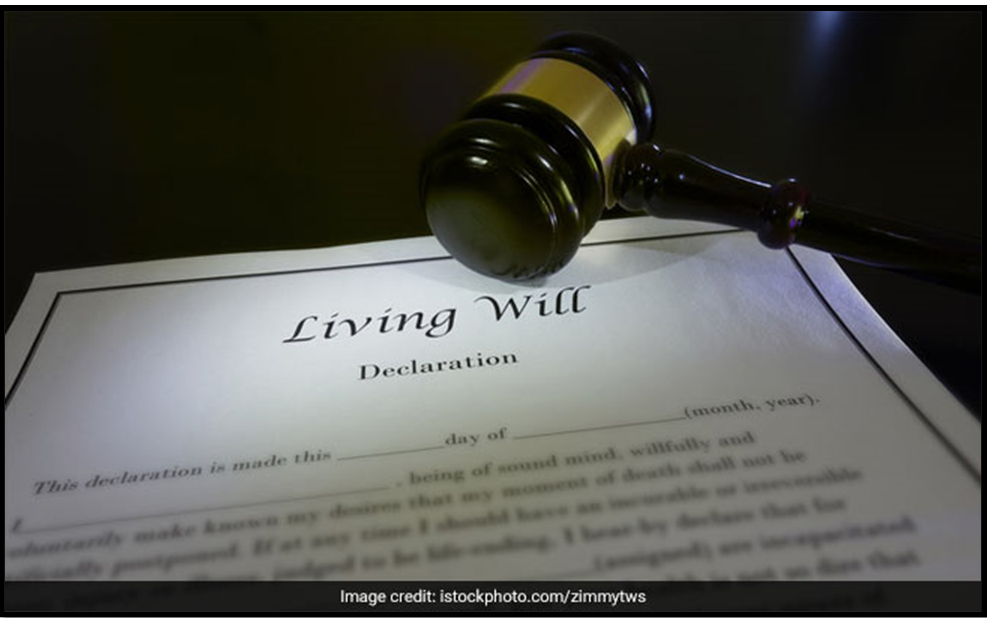LIVING WILLS- STATUS OF EUTHANASIAIN INDIA:
Syllabus:
GS 2:
- Constitution of India —historical underpinnings, evolution, features, amendments, significant provisions and basic structure.
- Government policies and interventions for development in various sectors and issues arising out of their design and implementation.
Focus:
- In early March this year, 30 people in Thrissur in Kerala executed living wills.
Source:- NDTV
What is living will?
A living will, also known as an advance directive, is a legal document that allows individuals to specify their preferences for medical treatment in the event they become incapacitated and unable to communicate their wishes. It outlines instructions regarding the types of medical interventions they do or do not want to receive, particularly in situations of terminal illness or irreversible coma. Living wills provide individuals with the autonomy to make decisions about their end-of-life care, ensuring that their preferences are respected even when they are no longer able to express them verbally.
The evolution of the concept of ‘Living Will’ in India can be traced through significant legal milestones:
- Law Commission of India (2006): In its 196th Report titled ‘Medical Treatment to Terminally Ill Patients (Protection of Patients and Medical Practitioners)’, the Law Commission clarified that a patient’s decision to refuse medical treatment did not constitute an act of suicide under Section 309 of the Indian Penal Code (IPC). Furthermore, it stated that a doctor who abides by the instructions of a competent patient to withhold or withdraw medical treatment does not breach their professional duty.
- Aruna Shanbaug case (2011): In this case, the Supreme Court of India allowed passive euthanasia for Aruna Shanbaug, a nurse who had been in a vegetative state for several years at a hospital in Mumbai. This decision marked a significant legal precedent regarding end-of-life care in India.
- Puttaswamy case (2017) / Right to Privacy case: The Supreme Court, in its landmark judgment on the Right to Privacy, held that Article 21 of the Constitution includes the concept of individual dignity. This recognition laid the foundation for acknowledging passive euthanasia as a component of the right to privacy.
- Common Cause case (2018): In this case, the Supreme Court of India legalized passive euthanasia and established guidelines for the implementation of living wills. The court’s decision provided a framework for individuals to express their end-of-life preferences in advance through living wills, ensuring that their wishes are respected in medical decision-making processes.
Active euthanasia V/S Passive euthanasia
|
Challenges:
- Complex bureaucratic procedures hindered the execution of living wills.
- The requirement for judicial magistrate countersignature proved burdensome and impractical.
- Few living wills were executed in the first five years due to these challenges.
- Lack of designated custodians for living wills in many regions, hindering their implementation.
- Absence of protocols for authenticating living wills through digital health records.
- Requirement for medical board certification complicates decision-making for patients and hospitals.
Reluctance from Authorities:
- Officials and state governments are hesitant to implement the judgment due to the complexity of the subject.
- Ambiguities in guidelines and absence of clear legal definitions further deter implementation efforts.
- State governments vary in their approach, with some issuing directions without essential guidance, while others take a more thorough approach.
Implications:
- Delay in implementing living wills affects doctors’ confidence in making end-of-life decisions.
- Legal implications create barriers to decision-making in intensive care units, impacting patient care and dignity.
- Urgent action is needed to bridge the gap between the Supreme Court’s judgment and its practical implementation for the benefit of terminally ill patients.
Potential Solutions:
- The Central government can provide model orders and protocols to guide state governments in effective implementation.
- Expert committees, like the one formed in Odisha, can facilitate detailed draft orders tailored to local needs.
- Persistent action and effective guidance from all levels of government are necessary to instill confidence in doctors to uphold patients’ wishes.
Various countries have diverse laws regarding euthanasia and assisted suicide:
|
Source: https://www.thehindu.com/opinion/op-ed/living-wills-implementation-lags-in-india/article68025071.ece
Mains Practice Question:
Discuss the challenges and prospects of implementing living wills in India following the Supreme Court’s landmark judgment in 2018. Examine the factors contributing to the delay in effective implementation, and suggest measures to overcome these hurdles. Assess the implications of delayed implementation on the healthcare system and the rights of terminally ill patients.
Case Study
In a scenario fraught with ethical and legal complexities, Dr. Gupta, an intensivist in a government hospital in India, finds himself at a crossroads when treating Mr. Rao, a terminally ill patient without a living will. Despite Mr. Rao’s deteriorating condition, Dr. Gupta hesitates to withdraw treatment due to the absence of clear guidelines and designated custodians for living wills in his region. Compounded by the ambiguity surrounding ‘next of kin’ and the need for medical board certification, Dr. Gupta grapples with the fear of legal repercussions and the ethical obligation to honor his patient’s dignity and autonomy. Meanwhile, bureaucratic delays and reluctance from state authorities exacerbate the situation, leaving Dr. Gupta torn between medical ethics, legal constraints, and institutional limitations. As the debate between autonomy and paternalism ensues, Dr. Gupta’s dilemma epitomizes the urgent need for comprehensive policy reforms and ethical guidance to navigate end-of-life care decisions effectively.




